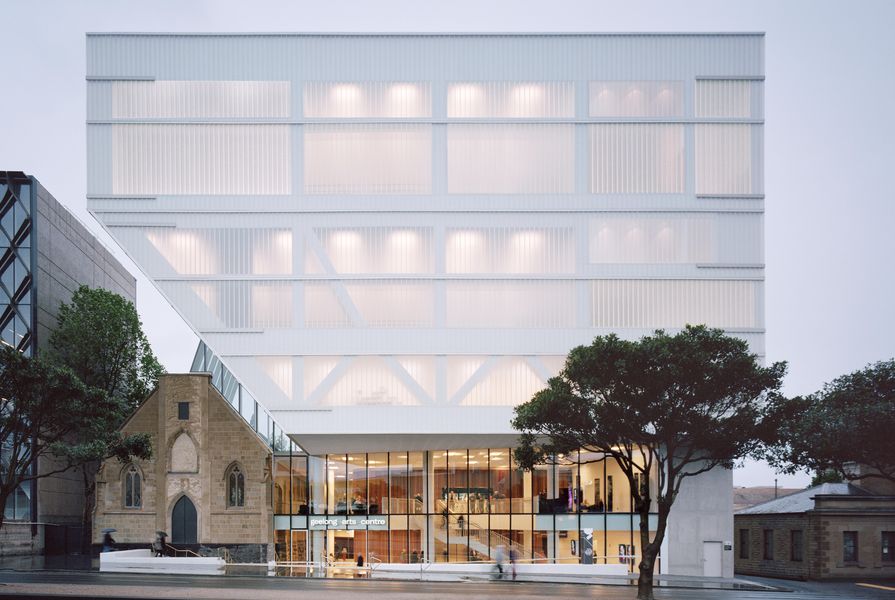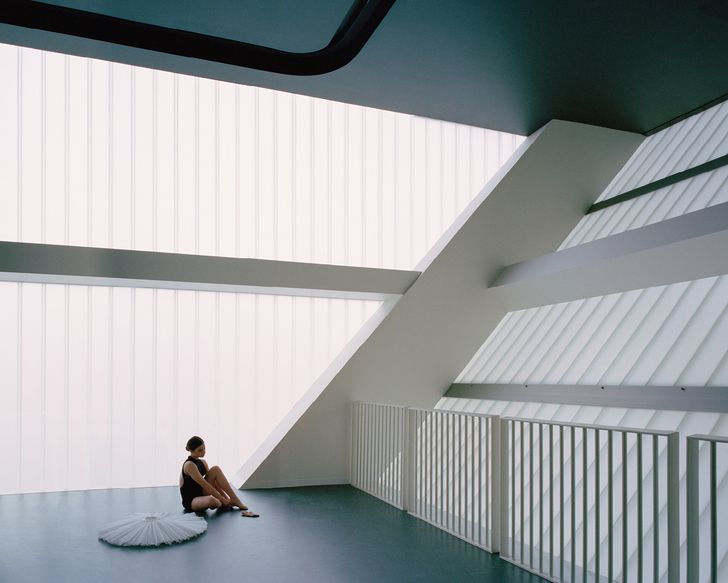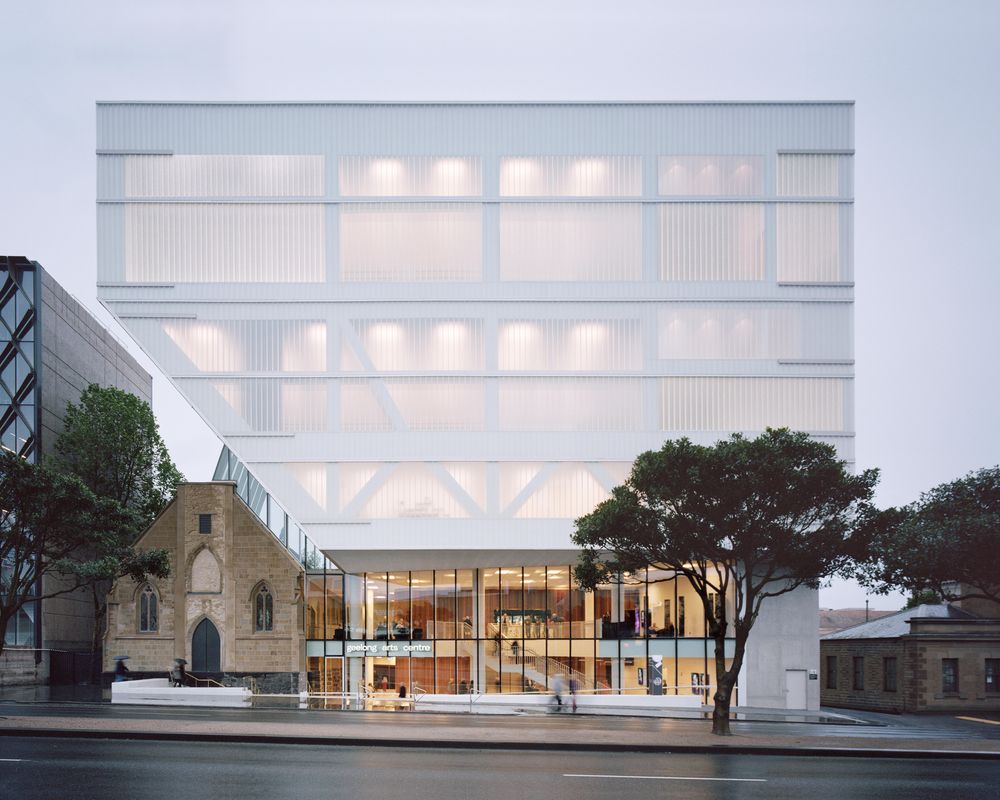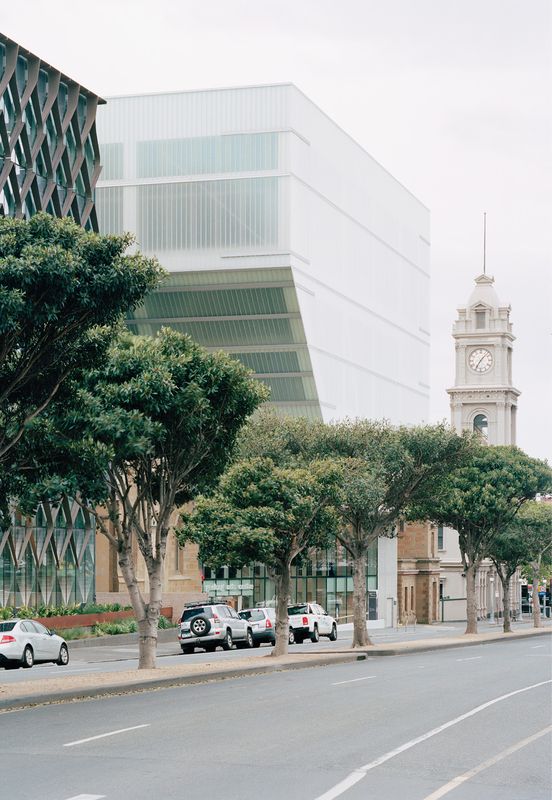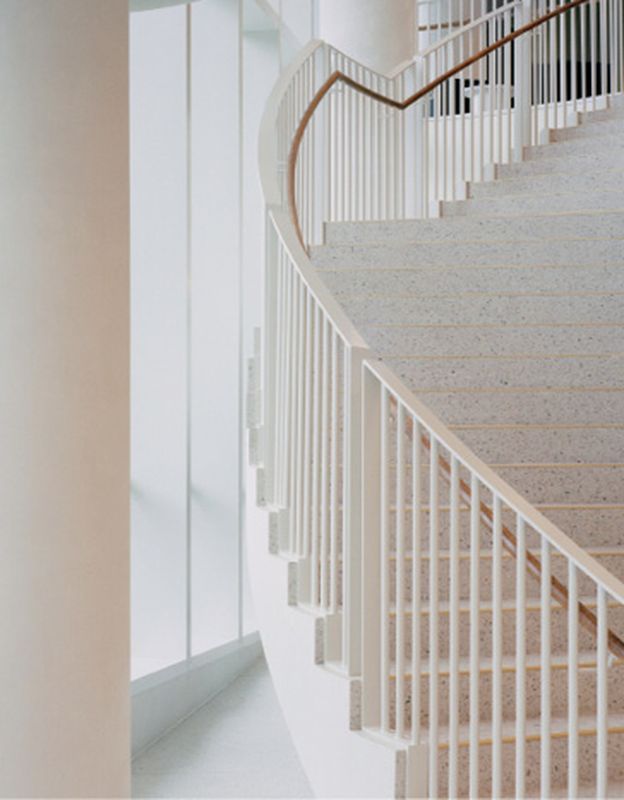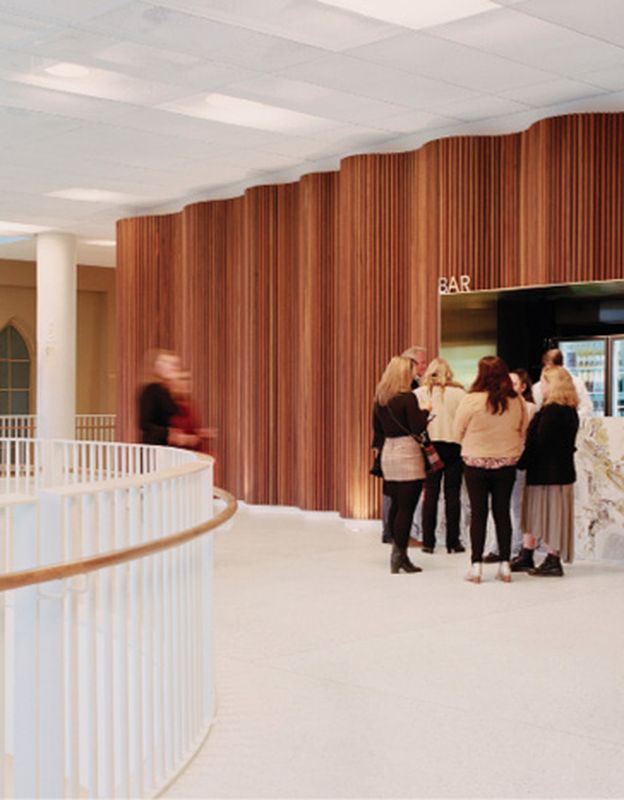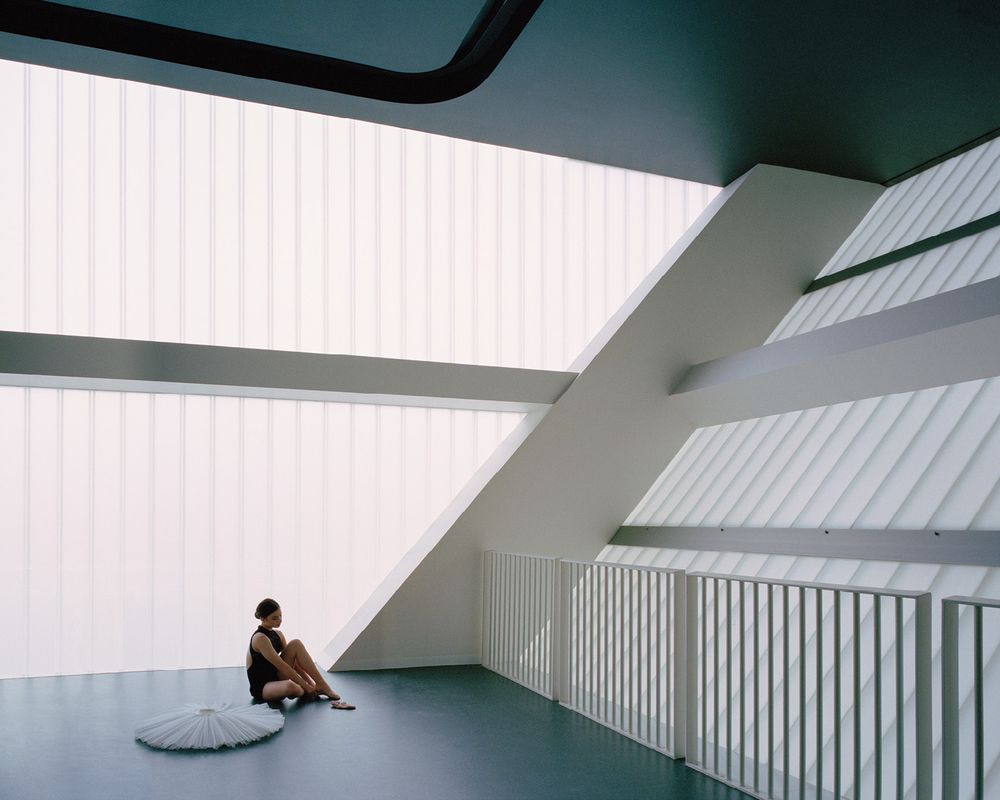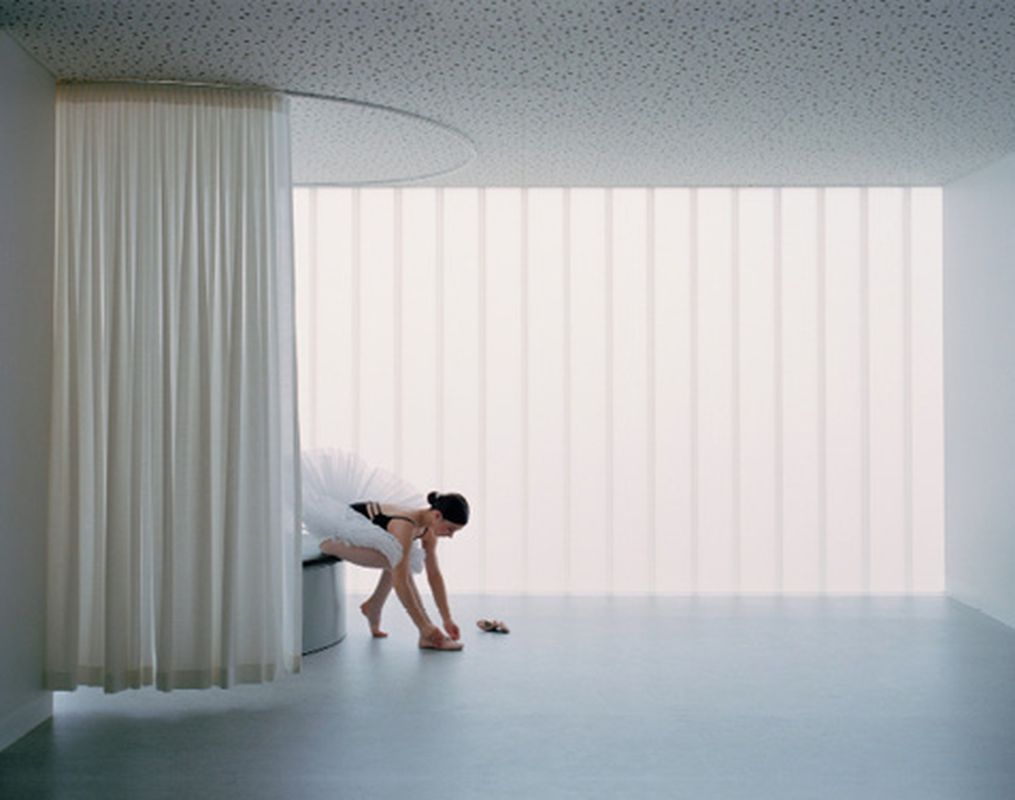Built on the lands of the Wadawurrung people and completed in November 2019, the new Geelong Arts Centre by Hassell has dramatically reshaped the city’s arts and cultural precinct. Once largely concealed from Ryrie Street behind the facade of the former Mechanics’ Institute and Plaza Theatre, the arts centre now asserts its presence as a glowing, translucent box that rises to match the scale of the neighbouring Barwon Water Headquarters by GHD Woodhead (see Architecture Australia July/August 2018).
Seen from afar, the new channel glass facade of the upper volume and the clear-glazed curtain wall of the foyer spaces below may initially read as somewhat independent formal gestures. In reality, however, the project has been carefully knitted into a series of existing structures in and around the site, most noticeably the remnant fabric of the Presbyterian Steeple Church on the western edge of the centre (which no longer has its steeple), but also some existing sections of the earlier performing arts complex, located at the site’s Little Malop Street end.
Where the masonry facade of the Mechanics’ Institute once stood, there is now a glass curtain wall that cuts back into the site. The removal of twentieth-century additions to the neighbouring Band of Hope building has revealed the old stonework of the Steeple Church. Anticipating its new life as a theatre in future development stages, the church has been incorporated into the arts centre’s new structure via the extended curtain wall, while the angle of the cantilevered sections of Hassell’s design has been drawn from the pitch of the church’s gable roof.
Hassell has knitted the new building into the existing structures in and around the Geelong arts precinct site.
Image: Rory Gardiner
The form of the 1980s Geelong Performing Arts Centre complex still frames the project’s Little Malop Street entrance, although this will change as part of the next stage of the site’s redevelopment. At present, the existing Playhouse Theatre, renovated by Studio 101 Architects in 2010, provides a point of intersection between the older parts of the building and the most recent additions.
Currently on display in the upper foyer level are some remarkably well-preserved paper tickets to the 1874 “Grand dramatic entertainment” fundraiser performance held at the Mechanics’ Institute. These vestiges serve as a reminder that a number of different venues have opened their doors to audiences on this site, long before the establishment of the Geelong Performing Arts Centre in 1981. However, the spatial requirements for live performance and arts venues have changed quite dramatically in the intervening years. The need for more immersive and adaptive performance and exhibition spaces has grown as relationships between audiences and performers have become more complex.
The new spaces created for what is now known as the Geelong Arts Centre, as well as the institution’s parallel rebranding, clearly respond to this shift toward the facilitation of a broader range of audience experiences and cultural productions. The diverse studio and co-working spaces situated within the translucent Ryrie Street volume are hireable venues that also form part of the centre’s Creative Engine, a development program for local artists and organizations. Access to the building through the Ryrie Street entrance has been considerably improved. Visitors are now able to move freely through the site at street level via a series of well-positioned ramps that operate in conjunction with stairs, running from the new sunken Ryrie Street plaza space along the western edge of the site and down to the slightly lower Little Malop Street entrance.
The ground and first floors of the new structure are largely devoted to foyer spaces for the playhouse stalls and balcony seating respectively. The floors and ceilings of each foyer are light, white and subtly textured using perforated sheeting at the ground floor and metal mesh above – a backdrop for the dramatic, undulating, rounded timber battens that wrap the playhouse on both lower levels. Within this battened curtain, deep brass reveals frame the theatre entrance at street level and bold marble bar on the first floor.
Visitor activity and circulation through each level of the foyer is registered on Ryrie Street through the uninterrupted curtain wall, tucked under the glowing, translucent volume overhead. The sweeping lines of a series of curved voids and the large staircase along the Ryrie Street edge frame quiet pockets in the foyer and offer smaller groups a place in which to gather. During evening events in particular, these patterns of occupation and movement are placed firmly on display for the precinct at these lower levels, in contrast to the occasional silhouettes offered by the co-working and performance spaces above.
Exposed steel framing elements are a consistent but gentle reminder of the scale and cantilevered position of the new building.
Image: Rory Gardiner
In the creative co-working spaces and the lobbies on the two upper levels of the centre, timber cabinetry elements, bold colours and even pattern create a more relaxed and playful atmosphere. These are not the spaces usually captured in professional photographs of projects of this type; it’s hard to resist the serious architectural drama of the studios – and this is an arts centre, after all. Nevertheless, these ancillary spaces are fundamental to the success of the institution and the realization of its more inclusive ambitions.
While the beautifully ethereal glowing box of the upper volume offers suggestions to passers-by of activity inside the studios, of greater intrigue is what it manages to keep hidden. Discovering the building’s playful moments and taking up the invitation to sit in the pockets of space that seem to effortlessly appear around the edges of an event will be a memorable experience for many visitors. The Geelong Arts Centre seems to recognize that the moments before and after the show are so often those charged with the responsibility of fostering meaningful and enduring relationships with the community.
Moving further up into the new levels of the arts centre, the exposed steel framing elements provide a consistent but gentle reminder of the scale and cantilevered position of the building. Bracing members zigzag through the co-working spaces while the studios above take full advantage of the larger, uninterrupted stretches of the channel glass facade.
The comparative restraint of the studio interiors yields to the almost overwhelming glowing edge of the channel glass facade, which is understandably celebrated at every opportunity. The studios command attention through scale, considered form and the thoughtful expression of material layers. Studios one and two, located on the third level of the complex, are fitted with barres along the length of each space. Mirrored interior walls reflect the softened light fed into the space through the translucent facade. On this level, as in the workspaces on the level below, the cantilever over the church is expressed internally by a raking wall.
In the Playhouse foyer, the undulating, rounded timber battens that wrap the theatre are set off by white floors and ceilings.
Image: Rory Gardiner
One of the most impressive features of the arts centre is studio four, located at the top of the complex. This studio is large enough to serve as a full-scale rehearsal space for the Playhouse Theatre and, as such, the acoustic demands placed on the space have called for an extra degree of separation from the channel glass facade. In response, a glazed layer runs around the Ryrie Street and western edges of the studio space.
The solid mirrored wall along the northern interior of studio four is abruptly punctured by a window that offers a view out to the Geelong foreshore and the granite ridges of the You Yangs beyond. This unexpected glimpse outside the centre is the only point of visual connection to the city of Geelong from the upper levels. This element was introduced quite late during the construction of the project and its presence is a testament to the close collaboration between architect and client, who discussed the opportunity to engage with the view while on site during construction. Taking into account the importance of the acoustic performance of this particular space, the challenge of incorporating a relatively long highlight window here seems important to note, if only because it lends further form to the energy behind the building’s ambition to connect to the city and the community.
— Alexandra Brown is an architect and senior lecturer at Monash Art, Design and Architecture. Her research explores twentieth-century and contemporary art–architecture relationships, as well as architecture and radicality from the 1960s onwards.
Credits
- Project
- Geelong Arts Centre
- Architect
- Hassell
Australia
- Project Team
- Mark Loughnan, Ben Duckworth, Harley Vincent, Scott Walker, Adriano Denni, Matthew Irvine, Steven Chiu, Kevin Cullis, Ed Mitchell, Lance White, Bobby Wong, Yoshia Kashima, Ryan Jayamaha, Prue Pascoe,, Clare Chippendale, Simon Rich, Noushin Atrvash, Ecknaath Bala, Jerome Delaunay, Lauren Geschke, Andrea Giuradei, Jacqui Low, Leah Hudson-Smith, Marine Rouanet, Anthony Thevenon, Mia Willemsen
- Consultants
-
Access consultant
Morris Goding Access Consulting
Building surveyor McKenzie Group
Food and beverage consultant The Maytrix Group
Heritage consultant Purcell
Planning Urbis
Services and Structural engineer AECOM
Signage and wayfinding Studio Semaphore
Theatrical and acoustic consultant Arup
- Aboriginal Nation
- Built on the land of the Wadawurrung people of the Kulin nation
- Site Details
-
Location
Geelong,
Vic,
Australia
- Project Details
-
Status
Built
Completion date 2019
Category Public / cultural
Type Culture / arts
Source
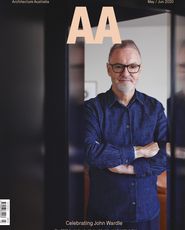
Project
Published online: 10 Nov 2020
Words:
Alexandra Brown
Images:
Rory Gardiner
Issue
Architecture Australia, May 2020

